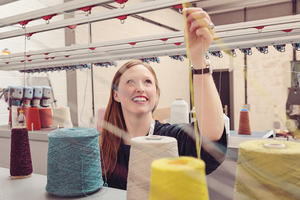
 |
Charlotte Stonestreet
Managing Editor |
| Home> | INDUSTRY FOCUSES | >Renewables | >We have the technology |
Editor's Pick
We have the technology
23 March 2022
Sustainability is seldom far from the headlines, but beyond the rhetoric more needs to be done to mitigate climate change. While technology does exist to achieve this, it is vital to ensure the solutions implemented actually deliver. Charlotte Stonestreet reports

IN THE latter part of 2021, the UK Government published its Net Zero strategy, which sets out a roadmap to address the climate emergency and support the UK in achieving its goal of net zero by 2050. Bringing together the UK's decarbonisation policies, the strategy highlights the importance of a holistic approach, recognising dependencies between vested departments and sectors. While acknowledging that the cost of inaction will be far greater than the investment required, the strategy also highlights that early action to achieve net zero can offer opportunities to strengthen the UK economy and, to quote one of the administration's favourite catchphrases, level up.
When it comes to industry specifically, the strategy proposes to decarbonise in line with net zero goals whilst simultaneously "transforming our industrial heartlands by attracting inward investment, future-proofing businesses, and securing high wage, high skill jobs". The aim is to achieve this by supporting industry in switching to cleaner fuels, helping improve resource and energy efficiency and using 'fair' carbon pricing to drive decarbonisation. According to the strategy, growing new industries in low carbon hydrogen alongside CCUS (carbon capture, utilisation and storage) and renewable energy will put the UK's industrial ‘SuperPlaces’ at the forefront of technological development.
Atmospheric CO2
At a recent industry event Ian Jackson from the Society of Operations engineers looked at how to address high atmospheric carbon dioxide concentrations.
"Equipment operation and its resulting energy consumption is a large contributor of additional emissions, in the atmosphere of CO2," said Jackson. "Engineering has the solutions to address this, however, many of the solutions currently championed appear driven by local optimisation and 20th century energy resource issues - neither of which are helping to solve today's global warming problem of high atmospheric carbon dioxide concentrations."
Jackson asserts that in addition to the necessity for a clear focus on reducing atmospheric carbon dioxide concentrations, what is needed is are solutions that actually deliver, underpinned by "rigorous and honest" measurement and reporting of net changes in atmospheric carbon dioxide concentrations. Indeed, part of the Society of Operations Engineers' role is to promote that all resulting actions are done safely, efficiently, sustainably and in an ethical manner.
"If we want to lower concentrations of carbon dioxide in the atmosphere, then we need to ensure that the rate of carbon dioxide flowing into the atmosphere is less than that flowing out," said Jackson. "We need to achieve 'net negative'; getting 'net zero' just keeps the concentration at the same high level."
In order to ensure actions are helping to reduce flows of extra carbon dioxide in the atmosphere, it is important to measure the actions against net changes; as Jackson points out, measuring actions against their outcomes is good engineering practice.
"Actions taken in the past do influence what happens today," says Jackson."Equally, actions being taken today will influence what happens in the future. However, because we are talking about flow rates rather than total amounts, flows occurring in the past or future do not affect the net difference in flow occurring today, and therefore, the net change in concentration occurring today."
A clear basis for judging the effectiveness of actions can be established by measuring the net flow that occurred on a particular day (today). It is then possible to determine whether the action is going to help lower carbon dioxide in the atmosphere.
Using energy sources such as solar, wind, nuclear, hydro and geothermal as energy sources helps reduce carbon dioxide emissions. However, points out Jackson, the problem is that while these represent 'good' energy sources they may not be effective as components of chemical reactions, for example in steel production. Issues include reliability and a lack of flexibility when responding to changes in demand.
Using carbon-based fuels with 100% carbon dioxide capture and storage also helps to reduce emissions, as well as supporting today's technologies and providing reliable and flexible electricity production. But, Jackson does ask the question of how sustainable this can be in practice.
"Clearly, by using all these engineering-based solutions together we have a measurement of safety and efficiently making significant reductions in carbon dioxide emissions for equipment operation," says Jackson "Further, in the long term we have the prospect of being able to end carbon dioxide emissions from equipment operation."
Better decisions
A recent study from ABB - 'Billions of better decisions: industrial transformation’s new imperative' – examines the current take-up of the Industrial Internet of Things (IoT) and its potential for improving energy efficiency, lowering greenhouse gas emissions and driving change.
“Sustainability goals more and more are a crucial driver of business value and company reputation, and Industrial IoT solutions are playing an increasingly important role in helping enterprises achieve safe, smart and sustainable operations,” said Peter Terwiesch, president of ABB’s Process Automation business area. “Unlocking insights hidden in operational data holds the key to enabling literally billions of better decisions throughout industry and acting upon them, with significant gains in productivity, reduced energy consumption and lower environmental impact.”
The study found that an organisation’s 'future competitiveness' is the single greatest factor – cited by 46% of respondents – in industrial companies' increased focus on sustainability. Yet while 96% of global decision-makers view digitalisation as 'essential to sustainability', only 35% of surveyed firms have implemented industrial IoT solutions at scale.
This gap indicates that while many of today’s industrial leaders recognise the important relationship between digitalisation and sustainability, the adoption of relevant digital solutions to enable better decisions and achieve sustainability goals needs to accelerate in sectors like manufacturing, energy, buildings and transport.
New material
One sector that is embracing digitalisation to drive sustainability and growth is the textiles industry. In the UK, 125 companies from the sector based in the North West are tapping into impartial expert technology advice, digital transformation workshops from the Made Smarter technology adoption programme to help them take their first steps, along with a leadership programme, digital technology internships, and skills development support.
Of these, 13 textile businesses supported by matched-funding, are investing in new digital technology to solve key challenges while increasing productivity, growth, and creating new high value jobs.
The fashion and textile industry is under substantial pressure to change to reduce its environmental and social impact. It is responsible for 10% of all global carbon emissions, water pollution from the use of chemicals and dyes and microplastics in the oceans, as well as staggering levels of waste. In the UK 300,000t of clothing – worth an estimated £140m – is sent to landfill or incinerated.
With the increase in consumer awareness of the devastating impact of fast fashion and a willingness among millennials to pay more for sustainable goods, the UK’s £32b fashion and textile industry has a huge opportunity to grow greener and more ethically.
Digital transformation is enabling a move away from traditional production methods and processes to make clothes, footwear and household textiles. Digital textile printing, for example, produces less waste, requires little set-up and equipment, and uses fewer resources like water. 3D printing also reduces waste as fewer samples, and therefore fabric, are produced.
Companies are opting to provide more data to boost transparency across the supply chain. QR codes, for instance, to detail the item’s country of origin and carbon footprint. Others are using analytics to track fashion trends and cycles, helping reduce the number of clothes that end up in landfill.
Managing supply chains
Supply chains are a valuable component of modern businesses, but they can account for the lion's share of a business's environmental footprint, highlights Neil Bellinger from EU Automation. Sustainability is a continuous practice with new technologies allowing companies to boost their positive environmental impact, he asserts. Leveraging Industry 4.0 technologies, such as AI and machine learning, helps businesses achieve transparency, energy efficiency and waste minimisation.
According to PwC and Microsoft, AI can help reduce global greenhouse emissions by 4 per cent in 2030, which is the equivalent of 2.4 billion tonnes of CO2 emissions. For example, AI-based predictive analytics can be used for more accurate predictions and planning. Smart software can predict changing customer behaviours and optimise inventory levels for better product life-cycle management.
New search and pattern recognition algorithms in machine learning can also analyse real-time data to schedule optimal scenario alternatives in case of product shortages and other unexpected events. This allows manufacturers to plan their logistics in advance to avoid waste and unnecessary transport that would generate CO2 emissions.
AI can also be used to support reshoring initiatives, whose goal is to move production closer to home to avoid long-haul transport. AI gives companies visibility into the entire supply market of vendors and manufacturers worldwide, shortening the search process from months to days.
For big organisations that rely on multiple suppliers and lengthy supply chains, it is not enough to ensure sustainable practices on their end. The idea of end-to-end (E2E) sustainability refers to monitoring the sustainability of the whole supply chain, from the procurement of materials to how the product reaches customers.
According to international non-profit firm CDP, the impact of end-to-end supply chains on emissions is more than five times that of companies’ direct operations.
While it might be challenging to overlook the entire supply chain and assess the sustainability of many suppliers, it is not impossible. Business owners can start by asking their first-tier suppliers to disclose their list of suppliers and relevant certifications on manufacturing and distribution. If some practices are not sustainable, they can encourage suppliers to adopt new ones or choose to collaborate with partners who prioritise sustainability instead.
Key Points
- UK Government's Net Zero strategy highlights that early action to achieve net zero can offer opportunities to strengthen the UK economy
- Using carbon-based fuels with 100% carbon dioxide capture and storage helps to reduce emissions, as well as supporting today's technologies
- Manufacturers can plan logistics in advance to avoid waste and unnecessary transport that would generate CO2 emissions.
- Let's not wait 50 years
- Malware targets industrial safety systems
- The growing need for agricultural automation
- Brexit shows its face
- Industry FOMO has to be a good thing, right?
- What would you do with Arduino?
- The new norm
- Looking beyond a temp solution
- How robots enhance workplace safety
- Track side story
- VALVE ACTUATION SUPPORTS OFFSHORE WIND FARM
- MAKING WAVES WITH TOUCHLESS TECHNOLOGY
- As Long As The Wind Blows
- Yokogawa Joins Friends Of The Supergrid
- Competence In Automation
- A renewed urgency for energy
- Turbine blade pitch control
- Transducer to reduce wind turbine costs
- Industrial Ethernet VARAN
- Wind sector O&M costs fall with Covid-19 induced work practices





















